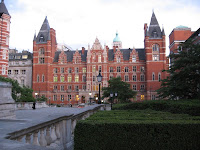 Here you can find an article written by Ms. Susan Jacob* as a guest blogger.
Here you can find an article written by Ms. Susan Jacob* as a guest blogger.
University of North Carolina (UNC) and Harvard scientists have recently teamed up to develop an inhaled tuberculosis vaccine. This vaccine is a godsend for developing countries, as it won't require refrigeration and medical-grade water like the typical vaccine.
Professor Tony Hickey, who teaches at the School of Pharmacy at UNC, tells The Kansas City Star, “This is arguably the first step towards future potential vaccines that elicit greater immunity to tuberculosis." Indeed, third-world countries are still being ravaged by the respiratory illness, which reportedly kills millions of people a year in developing areas.
This new inhalant was created by taking the regular tuberculosis vaccine and changing it into fine powder. Experts from both UNC and Harvard collaborated on this project in the laboratory of David Edwards. Edwards is a professor of biomedical engineering at Harvard. The development of the new vaccine was made possible by a grant from the Bill and Melinda Gates Foundation.
Though the inhalant has yet to be tested on human subjects, guinea pigs have responded well thus far. Scientists have administered the drug to the animals, then exposed them to tuberculosis. Not only did the vaccine work well, it appeared to be even more effective than the regular vaccine injections.
The new vaccine will be administered with a plastic tube, which is reportedly similar to a drinking straw. The inhalant is taken orally, which can pose problems with young children. To combat this issue, a special pacifier may be designed for babies to that the inhalant will be blown into the back of their mouths.
The next step to getting the drug on the market is to begin human clinical trials. Hopefully, the vaccination could be used in South Africa as soon as 2009.
*Susan Jacobs is a teacher, a freelance writer as well as a regular contributor for NOEDb, a site helping students obtain an online nursing degree. Susan invites your questions, comments and freelancing job inquiries at her email address susan.jacobs45@gmail.com .







